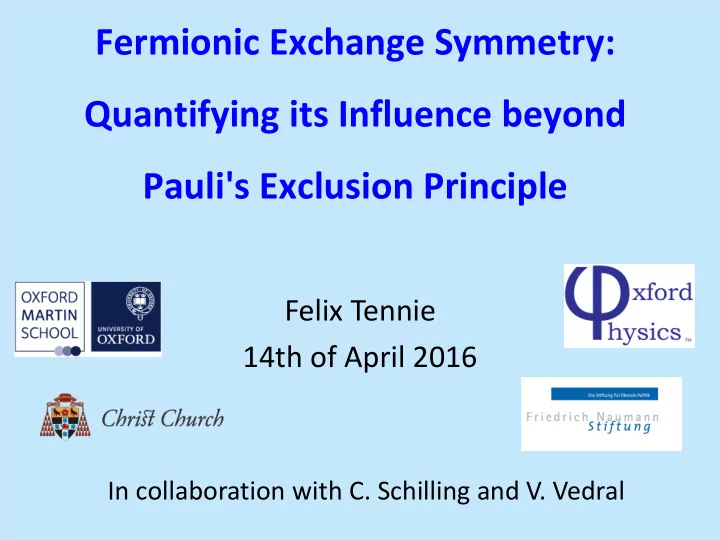

Fermionic Exchange Symmetry: Quantifying its Influence beyond Pauli's Exclusion Principle Felix Tennie 14th of April 2016 In collaboration with C. Schilling and V. Vedral
Pauli‘s Exclusion Principle (1925)
Antisymmetry of wave function (Dirac 1926) Pauli‘s Exclusion Principle Pauli‘s Exclusion Principle Antisymmetry of wave function What‘s beyond Pauli‘s Exclusion Principle?
Outlook 1. Generalised Pauli constraints revisited 2. Pauli Exclusion Principle and hierachy of pinning 3. Quasipinning measure Q 4. Relevance of Q 5. Study of physical systems
(1) Generalised Pauli constraints revisited
Komprimiert Generalised Pauli Constraints (GPCs): N-fermion wave function antisymmetry: Further constraints beyond Pauli‘s Exclusion Principle (PEP), on spectrum of 1-particle density operator:
GPCs: geometrical illustration Geometrically: Polytope
Impact of GPCs on Physics beyond PEP Here? 1 Or here? 0 1
Example: (N=3,d=6)-setting Constraints:
Example: (N=4,d=10)-setting Pick a constraint: Set 𝝁 𝟐 = 𝟐 : ? ? ?
Do the remaining constraints imply equality? ? such that 𝝁 𝟐 = 𝟐 and 𝝁 𝒋 ≥ 𝝁 𝒋+𝟐 ≥ 𝟏 , together with: ...
(2) Pauli Exclusion Principle and hierachy of pinning
PEP revisited (1) • Consider N fermions in d-dimensional 1-particle Hilbert space -vector to the `Pauli Simplex´: • PEP restricts decreasingly ordered 𝜇 Since one has: Sometimes pinning of PEP constraints can imply pinning of GPC(s)!
PEP revisited (2) • PEP constraints can be written more formally as: • Introduce the corresponding facets of the Pauli simplex: • Facets obey inclusion relation:
Example: (N=3,d=6)-setting
Hierachy of Pinning (1) • Crucial Observation: For any pair (r,s) pinning by corresponding PEP imposes pinning for a GPC 𝑬 𝒌 IF AND ONLY IF 𝒬⋂𝚻 𝒔,𝒕 ⊂ 𝑮 𝒌 ≡ {𝝁 ∈ 𝒬 |𝑬 𝒌 𝝁 = 𝟏} (#1) • Relation (#1) can therefore more easily be written as:
Hierachy of Pinning (2) • Due to inclusion relation of Pauli facets, Σ 𝑠,𝑡 ⊆ Σ 𝑠´,𝑡´ , natural class structure on the set of GPCs arises: • comprises of all GPCs that are pinned whenever PEP 𝑇 𝑠,𝑡 is pinned • Hierachy of classes and partial ordering on (r,s): • Determine smallest (r,s) for which GPC 𝐸 𝑘 is still in class
Example: Classes in the Borland- Dennis Setting (N=3,d=6) • Recall Borland-Dennis setting: = 𝜇 5 + 𝜇 6 − 𝜇 4 ≥ 0 𝐸 𝜇 • D contains Hatree-Fock point, i.e. belongs to class 𝒟 3,3 ∈ 𝒬 ∩ Σ 2,2 • D also contains 𝜇 (which is again the Hatree-Fock point), i.e. belongs to class 𝒟 2,2 • D further belongs to class 𝒟 1,1 Hierachies in higher dimensional settings become very complex and can be evaluated by linear algorithm
(3) Quasipinning measure Q
Quasipinning and distances to facets of constraints • Pinning by PEP constraints was found to impose pinning of certain related classes of GPCs • This can be extended to quasipinning • Distance to facet 𝐺 𝐸 𝑘 of GPC 𝐸 𝑘 is given by: • Note that the 1-norm is the most natural choice of a distance measure due to the inclusion relation of GPCs and normalisation condition Supl. Mat. arXiv1509.00358
Upper bounds on 𝑬 𝒌 (𝝁) • Flat geometry of polytope imposes linear upper bounds on the distance to the polytope boundary: • Hierachy of classes 𝒟 𝑠,𝑡 suggests to use minimal pair (r,s) -vector to Pauli Compare distances of 𝜇 facets and GPC facets!
Q-measure • Define Q-measure by: • Minimal distance to polytope boundary is 10 𝑅 𝑘 (𝜇) smaller than could be expected from approximate saturation of PEP!
(4) Operational significance of Q
Structural Simplification of the N-fermion wave function • Pinning of PEP and GPC constraints allows for a simplified expansion of N-fermion wave functions by a reduced number of Slater determinants: • Expand: • Q evaluates the ratios of 𝑀 2 -weights:
(5) Q-measure of Harmonium Ground States
Quasipinning in Harmonium Hamiltonian: Ground states:
Previous results: 𝝀 𝟗 -Quasipinning in 3-Harmonium in 1 dimension for weak interactions (CS et al, Phys. Rev. Lett. 110 , 040404 (2013) ) Strong interactions? More particles? Higher dimensions? Spinful particles? Dimensional crossovers?
𝐎 ≥ 𝟓 particles in d = 1 dimension More particles: Nontriviality: For d=1, quasipinning increases with the particle number! [FT, D.Ebler, V.Vedral, C.Schilling, arXiv:1602.05198]
Previous results: 𝜺 𝟗 -Quasipinning in 3-Harmonium in 1 dimension for weak interactions (PRL CS ’12) Strong interactions? More particles?
Strong interactions, e.g. for N=3 particles in 1 dimension: Concept of Truncation: C. Schilling: PhD Thesis, ETH 2014 Quasipinning extends to intermediate interactions; truncation methods hold even up to ultrastrong couplings!
Previous results: 𝜺 𝟗 -Quasipinning in 3-Harmonium in 1 dimension for weak interactions (PRL CS ’12) Strong interactions? More particles? Higher dimensions?
3 spinless fermions in 2 dimensions
4 spinless fermions in 3 dimensions Quasipinning becomes weaker with additional dimensions!
Previous results: 𝜺 𝟗 -Quasipinning in 3-Harmonium in 1 dimension for weak interactions (PRL CS ’12) Strong interactions? More particles? Higher dimensions? Spinful particles? Dimensional crossovers?
3 spinful fermions in 2 dimensions
Previous results: 𝜺 𝟗 -Quasipinning in 3-Harmonium in 1 dimension for weak interactions (PRL CS ’12) Strong interactions? More particles? Higher dimensions? Spinful particles? Dimensional crossovers?
Summary • Pinning of GPCs can be a consequence of pinning by PEP constraints • GPCs are seen to be hierachally ordered in classes • As result of comprehensive geometrical analysis: Q-measure, determining relevance of GPCs beyond PEP • Application to model system revealed significance of GPCs for Physics FT, V. Vedral and C. Schilling; arXiv1509.00358 FT, D. Ebler, V. Vedral and C. Schilling; arXiv:1602.05198, PRA: in press FT, V. Vedral and C. Schilling; forthcoming (2016)
Finis
Recommend
More recommend